Doctor Marco Lazzarotti teaches Social Anthropology at the University of Heidelberg in Germany. His research revolves around the effect of Catholicism on the tradition of ancestor rites in Taiwan, interreligious and intercultural dialogue, and the modernization of funeral rites in the country.
In 2020, he published a book, Place, Alterity, and Narration in a Taiwanese Catholic Village. It gathers and analyses stories shared by people living within and around a small Christian village in the western part of Taiwan.
Between August 2008 and October 2011, he conducted extensive fieldwork to grasp the ways local Catholics, Presbyterians, and non-Christians approach religious coexistence.
The research was conducted in a very rural environment in the western part of the island which usually does not get the attention of scholars of Christianity in Taiwan.
The normal focus is on North Taipei, the urban area, and on the east with all the aboriginal groups that have converted massively to Presbyterianism and Catholicism. In the unusual research, Lazzarotti for the first time provides a long analysis of what's going on in the western part of the island where the Chinese popular religion is very dominant.
He found a small village lost in the middle of those fields with Christian farmers either Catholic or Presbyterian -- coexisting with non-Christian Taiwanese.
In his book, he argues that the village is “a spatial, social, and ontological entity that emerges through the practice of storytelling.” In other words, through storytelling, local people create a “plausible image of a credible world” in which various humans and deities can co-exist.
What brought you to study Catholics in Taiwan?
I’m Italian and I arrived in Taiwan by chance. My sister, who was studying in Italy, met a Taiwanese man, and eventually, they got married. When they went to Taiwan, they invited me to go there. So, after I finished my first master’s degree in Italy at the University of Pisa, I decided to go to Taiwan and study Chinese. After two years, my sister and her husband divorced. But at that time, I had already applied for a Master’s in Anthropology at the National Taiwan University. So, I decided to stay in Taiwan.
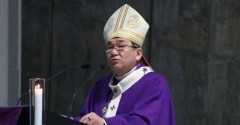
Christianity has deep roots in European culture, there's no hiding that, says Isao Kikuchi
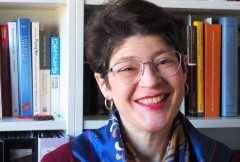
There is a belief in Karen mythology that sees education, or an idea and knowledge, as a kind of gift that has meaning for development
Could you tell us some of the stories shared by the villagers?
There are many stories, but I choose one that I think is very representative of my idea of research. It is a story told by a Christian plumber. He was a very famous person, even among the non-Christians, because he was working in many houses and temples, especially in the small townships in the countryside, where there are plenty of Taoist or traditional religious temples.
They were building a new temple and he was working on it. Once the temple was built, it was very important to constantly burn incense sticks inside. Not everybody can go and change the incense sticks. There are some beliefs linked with the idea of Feng Shui that in some moments some people, depending on their zodiac sign cannot go into a temple.
And there was a specific moment when nobody was allowed to enter this temple and change the incense sticks. But it was very important to keep the sticks burning. So, our Catholic guy said: “Okay, no problem, just give me the sticks, I will go inside the temple, I will change, and burn them.”
“But which Chinese zodiacal sign do you belong to,” they asked him.
“I am a monkey,” he said. But the monkey was one of the forbidden signs at the time.
“Come on, I’m a Catholic. I don’t believe in this kind of stuff. So, if you want I am happy to help.”
As he was completely outside of the cultural context of Chinese Feng Shui, and the Chinese zodiac, they decided to let him into the temple and change the incense sticks.
This was one of the first stories that I heard about the interactions between Catholics and non-Catholics in this township.
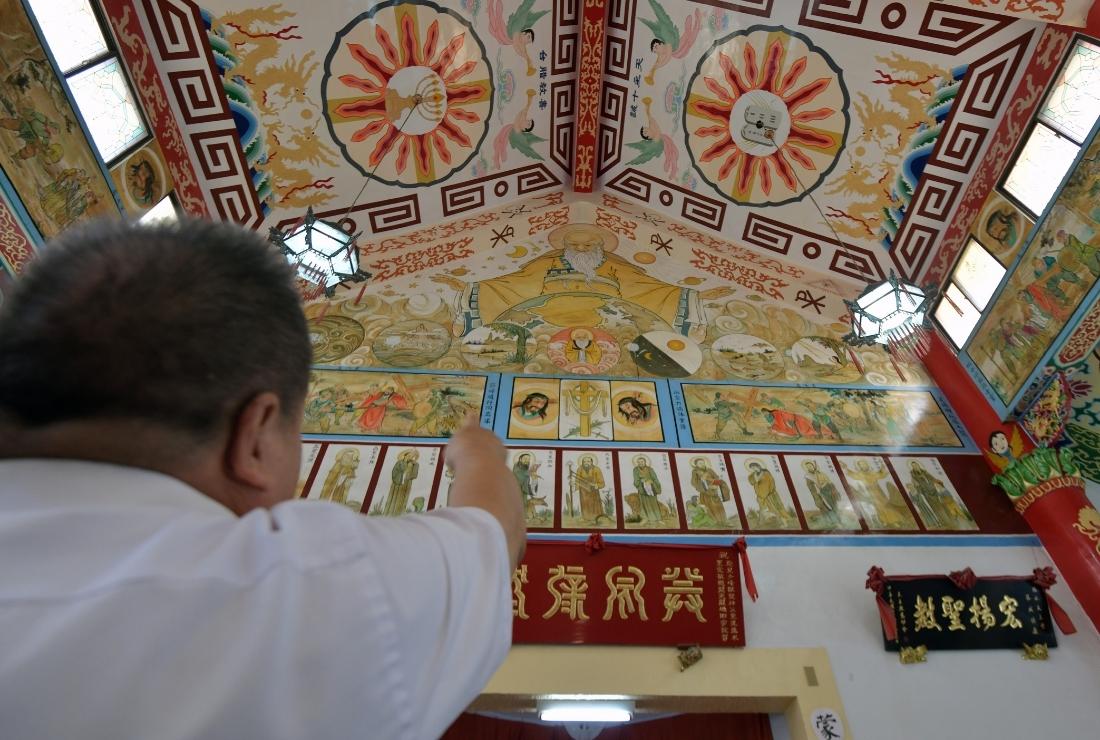
This picture taken on Aug 10, 2018, shows priest Joseph Chung introducing paintings in the Holy Spirit Church in Yanshui, about an hour's drive from the southern city of Tainan. With a cross rising from a red pagoda roof and two lion statues guarding the entrance, a Catholic church in southern Taiwan could easily be mistaken for one of the ubiquitous temples dotting the island. There are more than 1,000 churches across the island but the Holy Spirit Church is particularly unique. (Photo: Sam Yeh/AFP)
What can you tell us about the main argument of your book?
In all my research, even in my previous research, I always considered an encounter or the meeting of two different religions or cultural systems, as a kind of dialogue. At such encounters, these two different entities can meet, start a dialogue and get to know each other.
Another basic point of this book is that, when we tell a story, we are not just telling a story about what is happening to certain people, but we are also building the world. We build the environment, where this story takes place.
It was quite evident in this small village, where most people were Catholics. When all non-Catholics from neighboring villages were referring to this village, they were not only telling a story about this village or about the people who inhabit it.
They were building this village as something other, something completely different from the taboo, from the cultural environment that they were used to. This is a place where life is completely different from the life of the people in non-Christian villages.
I began to think about how to bring this idea of dialogue into this context. That’s when the idea of this “circuit of narration” came to my mind. For dialogue, you need two people. When we tell a story, we also build a world using some concepts, symbols, and notions that we have in our mind, which are linked to a particular culture and its background.
But very often when people from the Catholic village and the neighboring villages engage in a dialogue, the two people who form the circuit of narration belong to different cultural environments and different cultural backgrounds. So, the construction of their world was sometimes completely different.
The interpretation of the very same event was completely different. For example, in the story that I just told you, it was okay for the Catholic person to go into the temple. But for the non-Christian person, it was a kind of taboo to let him enter this temple and change the incense sticks.
We have an event here and also an interpretation of it. The interpretation is based on the differences between these two cultural systems of the two cosmologies. I tend to consider it as a cultural system, as a public system of symbols, which are understood by the people who live in this place.
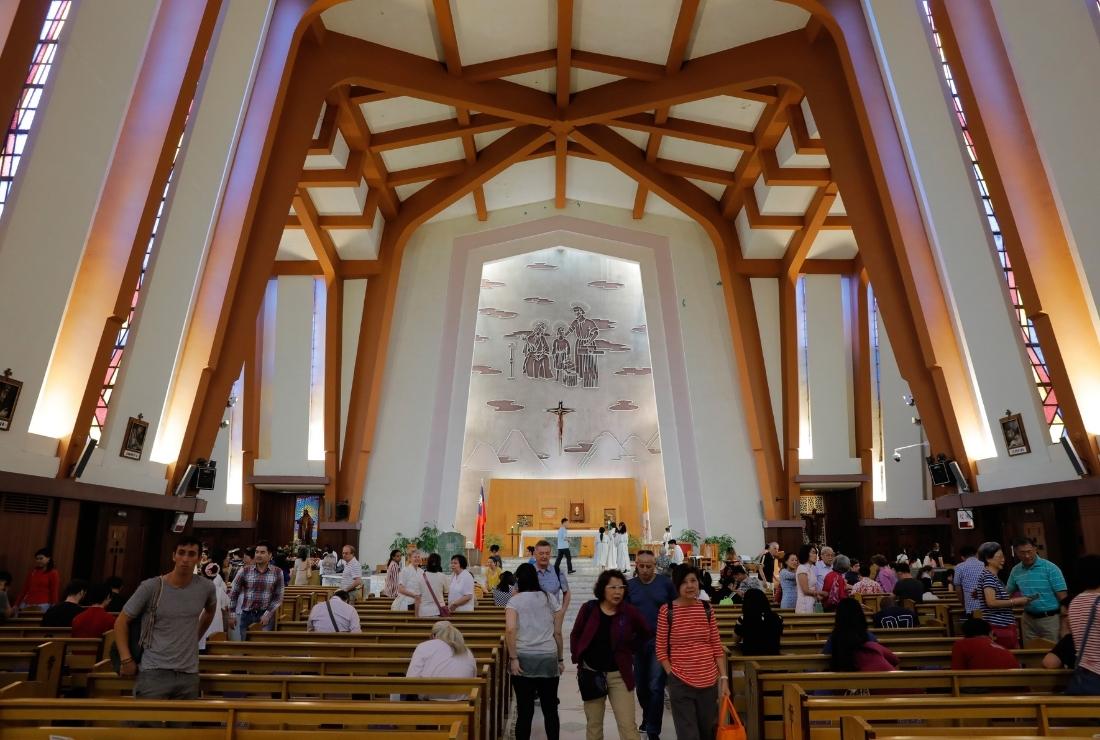
Worshippers leave after a service at the Holy Family Church in Taipei on Sept 23, 2018. Worshippers at masses in Hong Kong and Taiwan on Sept 23 were largely upbeat about a new deal between China and the Vatican despite fears Beijing is trying to up control of the Church. (Photo: Daniel Shih/AFP)
Can you tell us more about the historical background of this village?
This village has a very interesting story. This village called Shuiwei, where I did my research is different from similar villages even in the similar area of the central part of Taiwan. This story also influenced the development of both the Presbyterian and Catholic churches until now.
Dominicans were missionaries here, who arrived in the central part of Taiwan from the south of Taiwan. They were the only missionaries in Taiwan until the end of the Second World War. Historically, there was some Franciscan presence in the eastern part, but they were not as important as the Dominicans.
Dominicans set up a series of stations as part of their common policy because they wanted to move around the island. It also helped missionaries to walk, maybe a day to reach the next station where another missionary or the Catechist was living. This was done just to maintain the communitarian life of the Dominicans.
It meant Dominicans had many places, in cities or villages around Shuiwei, but not in Shuiwei itself. However, the Presbyterians were very active in this area. They even sent Scottish and Canadian missionaries to evangelize in the central part of the island.
And one of them was in Shiluo, one of the bigger cities in this area. This missionary had a bicycle, and he was using it to visit parishioners and bring the gospel to people. But at that time the bicycle was a new thing in Taiwan. So, it was a kind of status symbol.
At the time, there were three brothers in the village. These brothers decided to go and pay a visit to this missionary because they wanted to see the bicycle, called an ‘iron horse’ in Chinese. They wanted to see a horse that didn't eat grass.
They were also the three bosses of the local mafia. Every time they went to collect protection money from the people, they also visited this missionary. One day they entered this Protestant church and happened to listen to the preaching.
“I give you my peace,” the pastor said as he was reading from the gospel.
And the boss, the elder of the three brothers said, “Okay, I am a mafia boss. I have everything: money and respect and all comforts. But I don't have peace because my life is always seen as shady. He told his two brothers that he wanted to live this kind of life and become a Presbyterian.
The second brother decided to follow the elder brother and eventually became Presbyterian too. But the third one decided to keep his old life. But one day a Catholic drug seller went into the village and he noticed the cross (of the Presbyterian church) and he started to bring the Catholic faith to the village.
The second brother left Presbyterianism to convert and become a Catholic at some point in time. The third brother did not convert and continued to lead the life he had before. That’s why in this village we have Presbyterians, Catholics, and non-Christians from the same family group, with the same surname. The village is half Presbyterian and half Catholic.
Unlike in many places in Taiwan, Christians in this village are very close to each other, although they are Presbyterians and Catholics. That’s because they are from the same family. This kinship also works in this religious sense in this place.
Another interesting thing about these Catholic villages is that no Catholic missionary brought the faith here. They decided by themselves to become Catholic.
And after many years, the Dominicans sent a priest to this village. That is the historical background of this village and its community.

A Taoist priest blesses food offerings at Bao'An Temple in Taipei on April 1, 2018. The temple was constructed in 1742 and inducted into UNESCO for cultural heritage conservation in 2003. (Photo: Chris Stowers/AFP)
What was your methodological approach and how is it specific compared to other approaches?
I'm an anthropologist. The basic method of anthropologists is called Participant Fieldwork, which means to go to a certain place. For example, I went to this village, and I lived there for three years with my family. So, what I did was interview and observe how people behaved. These three years of work came after seven years of living in Taiwan. So, I was able to notice how different some of the customs, and behaviors of the people were. I was comparing that to the Taiwanese cultural religion mainstream. The method was living with them, interviewing, and making a lot of friends. This is the specific approach of anthropology. As anthropologists, we usually don't go for questionnaires or quantitative research. Our approach is much more qualitative.
What has been the most challenging in this research?
To tell you the truth, it was not so challenging, because Taiwanese people are among the most welcoming people on earth. They would come and welcome me and my wife and my son. After my son was born there, we became part of the village.
The place I lived in Taiwan had big vegetable farms. Almost daily, someone would bring something to us as a present and that was really meaningful for us. The most difficult part was, maybe, the hot Taiwanese summer. This was sometimes a bit challenging for me. But it's not a big problem.
In the village, where we were living, the majority were Catholics, including me and my wife. It has been quite easy, let's say, to get into the community and to be accepted.
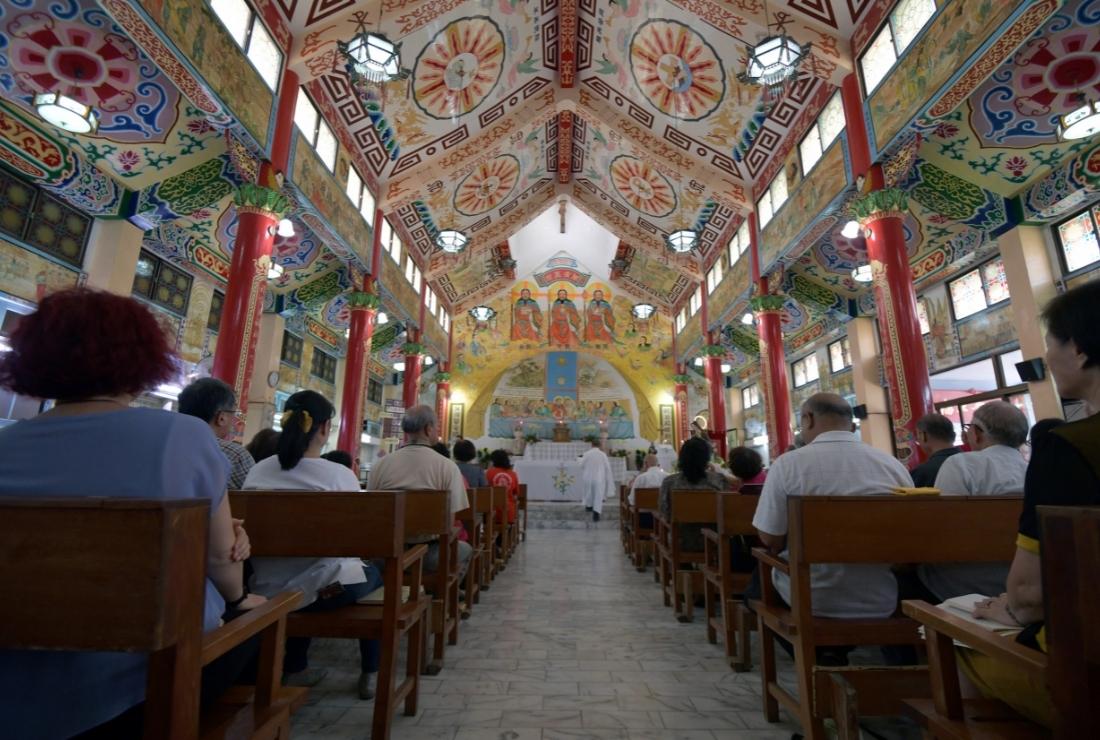
This picture taken on Aug 10, 2018 shows worshippers attending Mass in the Holy Spirit Church in Yanshui, about an hour's drive from the southern city of Tainan. (Photo: Sam Yeh/AFP)
How is your research impacting your understanding of world Catholicism?
What I learned from my research, especially for my faith, is that the Church is a plan of God. I mean, God is bringing up his Church, and He is developing his Church. It is really the work of God. We have to be faithful and have hope that He is giving rise to his Church and He is leading his Church.
Another thing for me was a change of mind regarding the idea of how to do missions, and how to become a missionary. In my experience, when I was doing this research about ancestor worship in the Catholic Church, for the most part, the people that I interviewed were converted as adults.
The cult of ancestors in Chinese culture is in fact one of the most important expressions that symbolize the respect and filial piety of the individual towards his parents and towards the ancestors of the family.
Ancestor worship has profoundly influenced the history of evangelization in China. Although the first Jesuits such as Matteo Ricci had positively evaluated these rituals, only after the Vatican Council, according to these customs, were they fully accepted and integrated into the Catholic liturgy.
My research shows how, in the Catholic context, the ancestors are venerated in particular with reference to Gesù, who is considered the first ancestor, the one and only begotten son of God and the first who rose from the dead.
Many of the experiences of conversion started from the presence of a colleague who was very nice to them and was always smiling, and always willing to help them.
Then they discovered that the person was a Catholic. Then they said that they remember when as a kid at the Catholic school the teachers were very kind to them.
What I mean is that the missionary process is not just brought on by missionaries, but by all Christians, by all the faithful.
What we have to do, even if we are not in a missionary context, is to try to be a good person, if you're a Catholic.
Try to bring love instead of hate and division. And this will help. The conversion of a person is not something we are doing but something that God is doing. But we have to give our contribution of course.

Share your comments